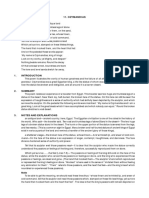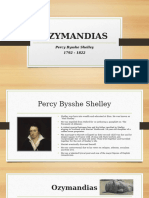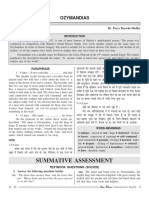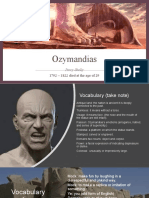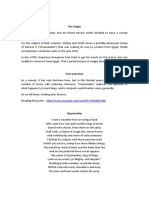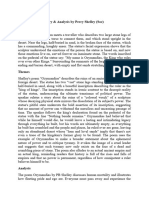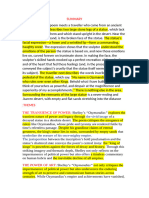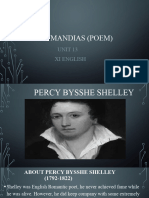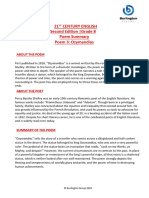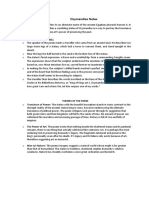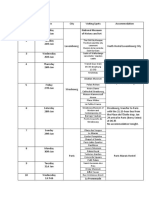0 ratings0% found this document useful (0 votes)
31 viewsOzymandius 1
Ozymandius 1
Uploaded by
TMPercy Bysshe Shelley's poem "Ozymandias" tells the story of a traveler who comes across a statue in the desert. The statue depicts a king named Ozymandias, with an inscription boasting that anyone who looks upon his works will despair at his great power and kingdom. However, all that remains is the statue's shattered legs and face, as the kingdom and ruler have long since decayed into nothingness. The poem warns that no earthly power or glory lasts forever, as even the mightiest of kings will one day be forgotten.
Copyright:
© All Rights Reserved
Available Formats
Download as PPTX, PDF, TXT or read online from Scribd
Ozymandius 1
Ozymandius 1
Uploaded by
TM0 ratings0% found this document useful (0 votes)
31 views6 pagesPercy Bysshe Shelley's poem "Ozymandias" tells the story of a traveler who comes across a statue in the desert. The statue depicts a king named Ozymandias, with an inscription boasting that anyone who looks upon his works will despair at his great power and kingdom. However, all that remains is the statue's shattered legs and face, as the kingdom and ruler have long since decayed into nothingness. The poem warns that no earthly power or glory lasts forever, as even the mightiest of kings will one day be forgotten.
Original Title
OZYMANDIUS-1
Copyright
© © All Rights Reserved
Available Formats
PPTX, PDF, TXT or read online from Scribd
Share this document
Did you find this document useful?
Is this content inappropriate?
Percy Bysshe Shelley's poem "Ozymandias" tells the story of a traveler who comes across a statue in the desert. The statue depicts a king named Ozymandias, with an inscription boasting that anyone who looks upon his works will despair at his great power and kingdom. However, all that remains is the statue's shattered legs and face, as the kingdom and ruler have long since decayed into nothingness. The poem warns that no earthly power or glory lasts forever, as even the mightiest of kings will one day be forgotten.
Copyright:
© All Rights Reserved
Available Formats
Download as PPTX, PDF, TXT or read online from Scribd
Download as pptx, pdf, or txt
0 ratings0% found this document useful (0 votes)
31 views6 pagesOzymandius 1
Ozymandius 1
Uploaded by
TMPercy Bysshe Shelley's poem "Ozymandias" tells the story of a traveler who comes across a statue in the desert. The statue depicts a king named Ozymandias, with an inscription boasting that anyone who looks upon his works will despair at his great power and kingdom. However, all that remains is the statue's shattered legs and face, as the kingdom and ruler have long since decayed into nothingness. The poem warns that no earthly power or glory lasts forever, as even the mightiest of kings will one day be forgotten.
Copyright:
© All Rights Reserved
Available Formats
Download as PPTX, PDF, TXT or read online from Scribd
Download as pptx, pdf, or txt
You are on page 1of 6
Ozymandias
Percy Bysshe Shelley
Percy Bysshe
Shelley
•
•
Born 4 August 1792 (Sussex, England)
Studied at Eton and Oxford, where he was
bullied books and clothes were torn.
• 1811 expelled from Oxford; Eloped and
married Harriet Westbrook (16) – two children
(son Ianthe and Charles); marriage collapsed,
ran away with Mary Goldwin (16) in 1814
married her in 1817, after Harriet drowned
(child – Percy Florence)
• Involved in the Romantic Era Movement
reaction to Industrial Revolution, moving back
to natural phenomenon
• Ideologies athesim, vegetarianism, free love,
and political radicalism
• Died (drowned in sailing accident) on 8 July
1822 (Lerici, Italy)
Ozymandias
I met a traveller from an antique land
Who said: Two vast and trunkless legs of stone
Stand in the desert. Near them, on the sand,
Half sunk, a shattered visage lies, whose frown,
And wrinkled lip, and sneer of cold command,
Tell that its sculptor well those passions read
Which yet survive, stamped on these lifeless things,
The hand that mocked them, and the heart that fed.
And on the pedestal these words appear:
“My name is Ozymandias, king of kings:
Look on my works, ye Mighty, and despair!”
Nothing beside remains. Round the decay
Of that colossal wreck, boundless and bare
The lone and level sands stretch far away.
Ozymandias
– Information
• 14 lined poem sonnet
– Doesn’t conform to neither Elizabethan not
Petrarchan style
• Rhyme scheme: ABABACDEDEFEF
– Made up of seven sentences in total
• Ozymandias – Greek name for the Egyptian
monarch Ramses II (13th Century BCE) who is
said to have erected huge statue of himself
Ozymandias
Poem shows that tyranny doesn’t last; warns that people of power
will one day be forgotten, too
Person roaming lands Ancient lands
I met a traveller from an antique land
Big/huge Legs that do not have torso of body (trunk) to carry
Who said: “Two vast and trunkless legs of stone
Is alone/ deserted in the desert
Stand in the desert. Near them, on the sand,
Half-buried broken face
What his face looks like
Half sunk, a shattered visage lies, whose frown,
Looks and believes to be
superior to all
And wrinkled lip, and sneer of cold command,
Sculptor read and captured
Tell that its sculptor well those passions read expressions well
Expressions survived, living on pieces of stone
Which yet survive, stamped on these lifeless things,
Hand mocked, showed power and arrogance
The hand that mocked them, and the heart that fed.
Heart gave meaning and life to people, fed
and nourished them
IRONY – pedestal shows power
and majesty, but nothing now The statue represents Ozymandias
- Name means:
remains
- Ozium = to breathe air
- Mandias = mandate/rule
And on the pedestal these words appear: Ruler of Air/Nothing
Important person; shows power,
‘My name is Ozymandias, King of Kings: influence over people of his day
Kingdom/ name Lose hope “look at my work, my name you who
thinks yourself as ‘mighty’ and you will
Look on my works, ye Mighty, and despair!’ lose all hope’
Negative connotation kingdom no longer exists
Rotted away/deteriorated
Nothing beside remains. Round the decay
huge Statue deteriorated too Kingdom now sand, vast
Of that colossal wreck, boundless and bare emptiness/ without an end
The lone and level sands stretch far away.”
King of ‘nothing’ /
‘nothingness’ immortal Ozymandias, being ‘the ruler of air’ gives sense
that ‘nature’ never disappears, no matter how
often mankind tries to adjust it. It is ‘air’/’nature’
that represents immortality, not mankind or
mankind’s possessions (i.e. statue)
You might also like
- The NamesakeDocument3 pagesThe Namesake019. Disha Das fybafNo ratings yet
- Ozymandias Question BankDocument9 pagesOzymandias Question Bankkeshavgurjar01875% (4)
- David Blaine Magic RevealedDocument19 pagesDavid Blaine Magic RevealedMario Vader100% (1)
- Pyrography Workbook A Complete Guide To The Art of WoodburningDocument146 pagesPyrography Workbook A Complete Guide To The Art of WoodburningJohn Strohl91% (11)
- OzymandiasDocument14 pagesOzymandiasb4b88nn9xfNo ratings yet
- OzymandiasDocument9 pagesOzymandiasmahnoorNo ratings yet
- Ozymandias - ShelleyDocument28 pagesOzymandias - ShelleyRori noloNo ratings yet
- OzymandiasDocument12 pagesOzymandiasmeghdyckNo ratings yet
- Slide With NotesDocument15 pagesSlide With NotesfoziaNo ratings yet
- P.b.shelley - RamsesDocument1 pageP.b.shelley - RamsesVanessa RidolfiNo ratings yet
- OzymandiasDocument2 pagesOzymandiasKANISHK SARASAWALNo ratings yet
- Y10 English Home Learning Power and ConflictDocument51 pagesY10 English Home Learning Power and ConflictJo PatrickNo ratings yet
- Poem of The Week 1 (GCSE Literature) WC 13 March 2017 - Ozymandius by Percy Bysshe ShelleyDocument2 pagesPoem of The Week 1 (GCSE Literature) WC 13 March 2017 - Ozymandius by Percy Bysshe ShelleyRahul Kumar SenNo ratings yet
- Percy ShelleyDocument16 pagesPercy ShelleymariliaferNo ratings yet
- OzymandiasDocument22 pagesOzymandiaschrismonse7No ratings yet
- OzyimandiasDocument6 pagesOzyimandiasAMULYA GUPTANo ratings yet
- OzymandiasDocument14 pagesOzymandiasHlompho.R MkaNo ratings yet
- OzymandiasDocument8 pagesOzymandiasKarnan ThilakNo ratings yet
- Ozymandias PPT Made by Manmeet SinghDocument21 pagesOzymandias PPT Made by Manmeet SinghManmeet SinghNo ratings yet
- OzymandiasDocument4 pagesOzymandiasdroslomaloNo ratings yet
- Ozymandias PDFDocument6 pagesOzymandias PDFSharon AngelineNo ratings yet
- OzymandiasDocument2 pagesOzymandiasmanyaasingh13No ratings yet
- OzymandiasDocument27 pagesOzymandiasZane De witNo ratings yet
- Power and ConflictDocument13 pagesPower and ConflictBrian SmithNo ratings yet
- Chapter 7 Poems in Focus (98-120)Document23 pagesChapter 7 Poems in Focus (98-120)M IIINo ratings yet
- OzymandiasDocument19 pagesOzymandiasNokukhanya HlabanganaNo ratings yet
- Calmly Writer OnlineDocument3 pagesCalmly Writer OnlineParthiva SinhaNo ratings yet
- Ozymandias: The OriginDocument5 pagesOzymandias: The Originjay7RNo ratings yet
- MockDocument7 pagesMockSahaj KhuranaNo ratings yet
- Paraphrase and Sample Answers From The Poem Ozymandias' by P. B. ShelleyDocument3 pagesParaphrase and Sample Answers From The Poem Ozymandias' by P. B. ShelleyRenan Sardar100% (1)
- ozymandiasDocument9 pagesozymandiasnl2089530No ratings yet
- English Ozymandias Qna'sDocument2 pagesEnglish Ozymandias Qna'skhan576rayyanNo ratings yet
- OZYMANDIASDocument18 pagesOZYMANDIASਕੇਸ਼ਵ ਗੁਰਜਰNo ratings yet
- English Project WorkDocument12 pagesEnglish Project WorkanandepcNo ratings yet
- $RR49BS3Document34 pages$RR49BS3Gullalai shahNo ratings yet
- Ozymandias of EgyptDocument7 pagesOzymandias of Egyptmlowe.spssNo ratings yet
- Power Revision SheetDocument1 pagePower Revision SheetMahjabeen BashaNo ratings yet
- Power and Conflict Poetry ClusterDocument33 pagesPower and Conflict Poetry ClusterFrances Gillen100% (1)
- 3I Wandered Lonely As A CloudDocument6 pages3I Wandered Lonely As A CloudBen AbellaNo ratings yet
- OZYMANDIASDocument4 pagesOZYMANDIASudits9248No ratings yet
- OzymandiasDocument4 pagesOzymandiasPrajwalNo ratings yet
- Poetry and Music. Kanye West and OzymandiasDocument3 pagesPoetry and Music. Kanye West and OzymandiasElena TanasucaNo ratings yet
- Ozymandias: Detailed Analysis of The PoemDocument4 pagesOzymandias: Detailed Analysis of The Poemmukesh50% (2)
- OzymandiasDocument6 pagesOzymandiasHira Tariq ButtNo ratings yet
- OZYMANDIASDocument2 pagesOZYMANDIASProf. Liaqat Ali MohsinNo ratings yet
- of OzymandiasDocument19 pagesof OzymandiaskeshavNo ratings yet
- TM - C28 - CI - C1 - Poem 3Document3 pagesTM - C28 - CI - C1 - Poem 3ranjitkaurnandha001No ratings yet
- Apstrophe To The OceanDocument12 pagesApstrophe To The OceanArduino CreatorsNo ratings yet
- Ozymandias NotesDocument2 pagesOzymandias Notesalena100% (3)
- Mock Upon Tyranny - An Analysis of Percy Bysshe Shelley's - OzymandiasDocument3 pagesMock Upon Tyranny - An Analysis of Percy Bysshe Shelley's - Ozymandiasanweshasaha2002No ratings yet
- Ozymandiasework 1Document15 pagesOzymandiasework 1SudarshanNo ratings yet
- CBSE Class 10 English Assignment - OzymandiasDocument5 pagesCBSE Class 10 English Assignment - OzymandiasParthiva SinhaNo ratings yet
- Lesson 18Document8 pagesLesson 18soibal100% (1)
- 2014 Lit Terms PoetryDocument7 pages2014 Lit Terms PoetrySaing SneikerNo ratings yet
- OzymandiasDocument9 pagesOzymandiasplanetmehekNo ratings yet
- "Ozymandias": by Percy Bysshe ShelleyDocument1 page"Ozymandias": by Percy Bysshe ShelleyKimderly JaimsNo ratings yet
- OzymandiasDocument10 pagesOzymandiasmnsparuiNo ratings yet
- Year 10 Power and Conflict Poetry Knowledge OrganiserDocument6 pagesYear 10 Power and Conflict Poetry Knowledge OrganiserLK100% (1)
- Revision Notes On The PoemsDocument98 pagesRevision Notes On The PoemsabasfordNo ratings yet
- Ozymandias Poetry Close Read AnalysisDocument3 pagesOzymandias Poetry Close Read AnalysisIana SheremetovaNo ratings yet
- Roman Lamps Discovered in Romula II LychDocument4 pagesRoman Lamps Discovered in Romula II LychGabriel GrumăzescuNo ratings yet
- Colors PDFDocument51 pagesColors PDFMaribel Melissa Blas CadilloNo ratings yet
- A Heart Full of LoveDocument9 pagesA Heart Full of LoveBruno SantosNo ratings yet
- Marbling 2Document2 pagesMarbling 2John AngNo ratings yet
- DSR PuneDocument5 pagesDSR PunedigvijayjagatapNo ratings yet
- WD Doors and Windows 01Document1 pageWD Doors and Windows 01Nagabharan GowdaNo ratings yet
- Claude Monet Contribution Art Presentation Green VariantDocument26 pagesClaude Monet Contribution Art Presentation Green VariantIlmu2 SMK Ilmu smk 12No ratings yet
- Gezi Planı TabloDocument4 pagesGezi Planı TabloSümeyye ErsoyNo ratings yet
- Plot No-996/1, Sector - 3D. Opposite GH-2, Gandhinagar.: Arms and The Man - An Anti-Romantic ComedyDocument2 pagesPlot No-996/1, Sector - 3D. Opposite GH-2, Gandhinagar.: Arms and The Man - An Anti-Romantic ComedyShahadat HossainNo ratings yet
- Living Spaces - Affordable Style Catalog 2020Document9 pagesLiving Spaces - Affordable Style Catalog 2020MladenNo ratings yet
- Edge Grinding - U.Sowell-B.Lingnell - TT03-2019Document31 pagesEdge Grinding - U.Sowell-B.Lingnell - TT03-2019Christian NunezNo ratings yet
- Year 10 Final 2023Document7 pagesYear 10 Final 2023Ralph Rezin MooreNo ratings yet
- Digital Booklet - RipcordDocument11 pagesDigital Booklet - Ripcordchayan_mondal29No ratings yet
- Boq Items TilesDocument1 pageBoq Items TilesAbd-Elaal Mohamed AmerNo ratings yet
- 8ed245fa-da0f-47f8-bc66-6f7745f2b503Document7 pages8ed245fa-da0f-47f8-bc66-6f7745f2b503marina100% (2)
- The Italian Schools of Fencing Art ScienDocument44 pagesThe Italian Schools of Fencing Art ScienluniamrNo ratings yet
- Amigurumi Polka-Dot Bunny Free Pattern - Tiny Mini DesignDocument9 pagesAmigurumi Polka-Dot Bunny Free Pattern - Tiny Mini Designsadhukarthi4484100% (3)
- 05 OnScreen 1 Unit 5Document14 pages05 OnScreen 1 Unit 5Марина ГрабовецькаNo ratings yet
- Haydn Program NotesDocument4 pagesHaydn Program Noteskimngkq96No ratings yet
- Fabrics-store-Beau Pleated Shirt Pattern-1Document51 pagesFabrics-store-Beau Pleated Shirt Pattern-1meNo ratings yet
- TitleDocument3 pagesTitleNiel Marc TomasNo ratings yet
- Icao Photograph Guidelines enDocument3 pagesIcao Photograph Guidelines enHammad HaiderNo ratings yet
- The Nightmare of Participation: Christel VestersDocument3 pagesThe Nightmare of Participation: Christel VestersAlma CardosoNo ratings yet
- College Essays ExamplesDocument6 pagesCollege Essays Examplesd3gymd53100% (2)
- Beginner DesignDocument10 pagesBeginner DesignibiloyepNo ratings yet
- Abstraction Eight Statements October 143Document49 pagesAbstraction Eight Statements October 143Egor Sofronov100% (2)
- OD2e L4 Reading Comprehension WS Unit 3Document2 pagesOD2e L4 Reading Comprehension WS Unit 3Nadeen Nabil100% (1)










